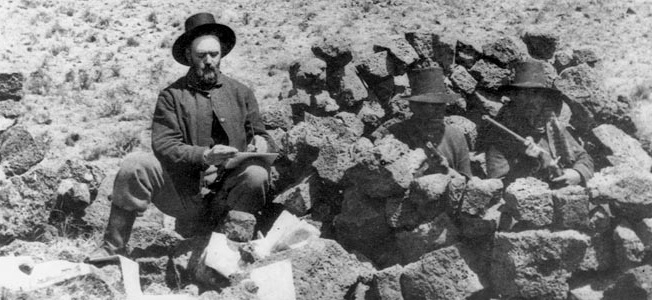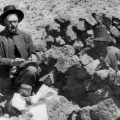
During the nineteenth century there were many conflicts between Indian nations and the Americans (settlers, militia, miners, military) which are called “wars” by historians and others even though most were not formal wars from a military perspective. In general, the United States laid the foundation for these “wars” or conflicts in a number of ways, including treaties, racism, and Christianity.
A treaty is simply an agreement between two sovereign nations. Since Indian nations, according to the Constitution, are sovereign nations, the federal government would negotiate treaties with these nations, the Senate would then ratify the treaties, and the President would proclaim them. In negotiating treaties, the Americans disliked Indian democracies and preferred to negotiate with the Indian chiefs—(dictators)—whom the Americans had appointed as those with whom they would negotiate. By ignoring and subverting traditional Indian leadership, the Americans often created the conflicts which resulted in violence.
In negotiating treaties, the American negotiators often used a combination of lies, false promises, bullying, and threats of force to gain treaties that were most favorable to the United States.
One of the fundamental features of American culture is racism: the view that some groups of people, such as American Indians, are somehow inferior, perhaps even subhuman, and thus do not need to be offered respect. The genocidal policies of the Americans included not only physical extermination, but the denial of basic rights such as the right to testify in a court of law.
Racism often blinded American treaty negotiators to the cultural differences between American Indian tribes. The American officials often viewed all Indians as the same, ignoring the cultural realities of differences among various tribes. According to this racist worldview, there were no differences between the Modocs, the Paiutes, the Klamaths, and other tribes: they were all “racially” Indians and therefore the same.
Under the Discovery Doctrine, the United States, as a Christian nation, claimed it had the right, if not the obligation, to rule over non-Christian nations, such as those of the American Indians. In addition, the United States sought to convert Indians to Christianity by force of arms as well as through the active suppression of American Indian religions.
All of these things—the treaty process, racism, and the suppression of Native religious practices—laid the foundation for the Modoc War of 1872-1873.
Background
In 1864, Elijah Steele negotiated a treaty with the Modoc in which the United States agreed to obtain a reservation for the Modoc along Lost River. However, the government did not submit the treaty to the Senate for confirmation as it had not been authorized by the Bureau of Indian Affairs. Attorney Doug Foster, in an article in the Oregon Historical Quarterly, writes:
“From the Modoc perspective, the government had unilaterally cancelled their treaty.”
Following the cancelled treaty, the U.S. government held a treaty council with the Klamath, Modoc, and Yahuskin (a Shoshone band affiliated with the Paiute) at Council Grove, Oregon. The government proposed that the three groups share a reservation in eastern Oregon. The Modoc were less than enthusiastic about this treaty as it meant moving away from their traditional territory. However, they felt that they had little choice, so Schonchin Jim signed the treaty.
In the treaty, the American government agreed to pay annuities and to pay for reservation improvements. The government, however, also reserved the right to place other tribes on the reservation.
There was a lack of food on the reservation and soon petty issues resulted in disputes between the Modoc and the Klamath. In response to these disputes, the Modoc asked for their own reservation along the Lost River north of Tule Lake. The request was rejected by both the federal government and the state of California.
The Oregon state legislature in 1864 passed a law which prohibited Indians and “half-breeds” from leaving their reservation without the permission of the Indian agent. Furthermore, the law made it a crime to help Indians escape from the Indian agent’s control.
In treaty negotiations and in the administration of reservations, the United States preferred to appoint leaders (i.e chiefs), ignoring any tribal customs regarding leadership or possible tribal sovereignty. In the process, the United States hoped to secure leadership that would be loyal to the United States and not to the tribe.
In 1846, Kintpuash (Captain Jack) had become a Modoc chief when his father was killed in an ambush by the Americans. In 1865, however, the Americans refused to acknowledge him as a chief. Subsequently, he led the Lost River Modoc off the reservation.
In 1869, American officials persuaded Kintpuash and his band to return to the reservation. At this time, the Lost River Modoc numbered about 43 people—men, women, and children. In spite of the American assurances, they found conditions on the reservation no better than when they had left four years earlier.
At this time, one of the primary functions of the reservation was to convert Indians to Christianity. In doing this, all traditional Indian religious practices, including shamanism, were not allowed. In 1870, Captain Jack led a larger group of 371 of his people off the Klamath Reservation and returned to their homelands in the Tule Lake area of Northern California. Once back in the Modoc homeland, Captain Jack steadfastly refused to budge.
American settlers in northern California complained about the Modoc presence and asked for federal troops to remove them.
In 1871, Captain Jack killed an Indian doctor for failing to cure one of his children—an action which was acceptable in Modoc culture. The Indian agent, however, ordered the military to arrest him for murder. In 1872, Captain James Jackson led a detachment from Fort Klamath with the intent of capturing the “renegade” Modocs and returning them to the reservation. This set the stage for the Modoc War.




Leave a Reply